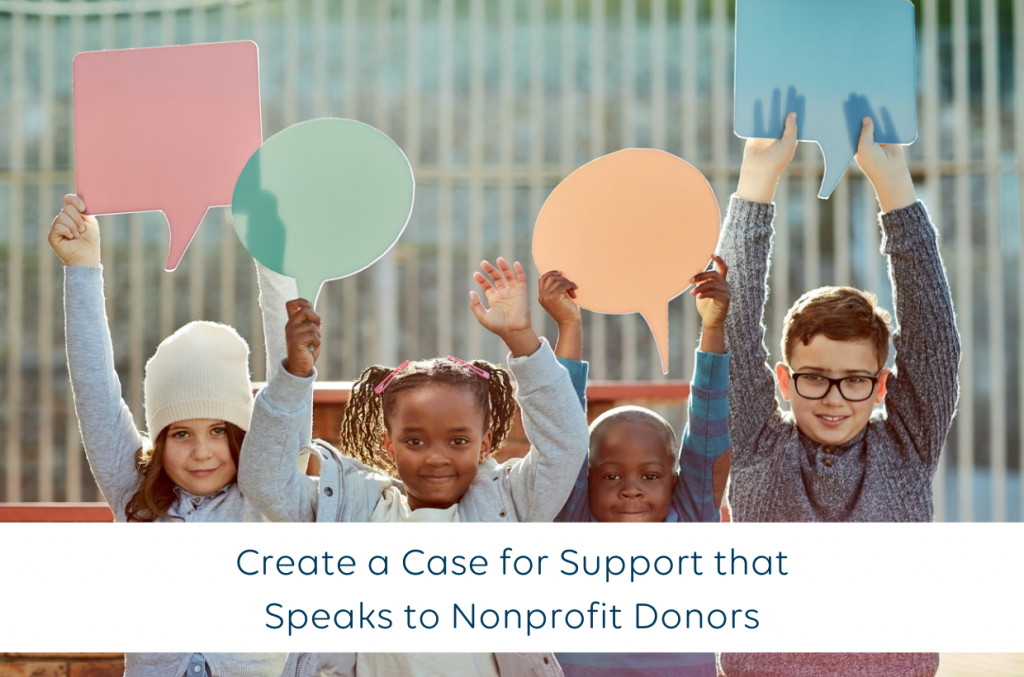
A case for support is a communication tool that tells the story of your organization, sharing emotional stories while also explaining exactly how you serve your mission.
As a nonprofit, your organization needs various tools and strategies in order to obtain the financial resources your nonprofit needs to run smoothly. A case for support is a major player in this strategy, like a hammer in a toolbox – with a case for support you’re equipped to start any fundraising project.
What will I find in a case for support?
Every case for support is custom to the nonprofit, yet a general starting point is to consider including:
Emotional Hooks: Present the problem your nonprofit is solving in a way that humanizes the story. Include personal stories and sprinkle statistics that showcase the need.
Vision for a better future: Present the solution you offer to solve this problem. This can include showing how people in opening stories benefited, and will also include stating your vision and mission.
History of the organization: Include the background story about why you got started, include relevant details that again work to humanize the story and the founders’ connection to the cause. This will also include historical milestones such as 501c3 established dates, new program launches, location moves, etc.
Importance and urgency: Consider where there is immediate timeliness to your issue that is relevant to current events or social issues, and explain why it is important to tackle this problem now.
Explanation of programs – Many organizations know what work they are doing but will struggle to break it down in a way that is digestible for someone on the outside. Creating a case for support forces you to create a “map” that offers a breakdown of programs so that they can be seen as individual pieces of your organizations’ larger puzzle.
Outcomes and Proof of Impact – If your organization has already created an positive change, then this is a great place to add another compelling story or any data about your work. If this data is not available, use research and statistics to prove why your solution will create change – and also use this exercise as an opportunity to brainstorm what data you should be collecting for future case for support statements.
Statement of financial needs/How you can help: This explains how much funding your organization needs, and for what? It can look like offering tangible giving level so that donors know the impact of their dollar. Explain where and how to give, and other ways to get involved. If you have a specific audience for the case for support – for example, individual donor, major gifts, corporate sponsor – you want to cater this section to match that audience subset.
How do I create a case for support?
A Case for Support is not just the writer’s words. Even if you are just starting out as a nonprofit, you can brainstorm a list of individuals to interview in order to gain valuable insights about the mission that will inspire the underlying story lines of your case for support.
Here’s some ideas:
- Board members
- Individuals affected by the circumstances you aim to improve
- Experts in the field of work
- Supporters and/or donors
Let’s say we’re writing a case for support for a tutoring and mentoring program. This could look like interviewing:
- Board members
- Parents of children struggling academically
- Teachers
- School district officials
With this list in place, what do you do next? Brainstorm a list of questions you will ask the individuals involved. What are the things you’d like to know from their perspective? Crafting about 7 to 10 questions is a good place to start, and conversation with each individual will create a natural discovery for more talking points.
Once your story collection is complete, begin to weave the narrative following the outline from the beginning. Weave in relevant research and statistics as it helps to explain your cause.

What will I do with my case for support?
A case for support is a multi-use and valuable tool for a nonprofit. You can create a booklet brochure (we have a wonderful template here) and use this to share with donors. You can print some copies for major donors, and also link the digital file to your website for easy online sharing.
The content from your case for support also creates a great foundation for …
- Updating website content
- Creating small brochures
- Crafting narrative for grant applications
- And many other communications
Leverage the power of a case for support
Bottom line, a case for support is a great tool for your nonprofit to improve its storytelling and communications with donors. A comprehensive case for support should include emotional stories, relevant research, historical information about your org, a detailed breakdown of programs and impact data.
The case for support should include more than one voice, as it tells the entire organizational story. This tool will help you improve your communications and convert more donors, and can be used in many ways to make this happen.
Get started
Presence&Company offers free sessions to discuss your nonprofit. Kickstart the case for support process with us: schedule today!

